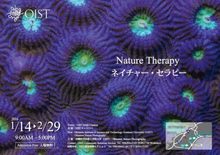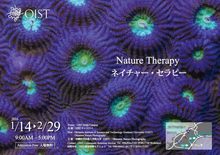Past Events
Rainy Teatime
Seminar by Prof Xiao 'Ultrahigh-Q optical microcavity optics and photonics'
Inventions and Startups from Basic Research - Innovation Seminar Series
Opening Ceremony: Photo Exhibition "Nature Therapy"
Nature Therapy Teatime
HEART All User Meeting (English)
Researcher Meeting
The next Researcher Meeting will be held on Thursday January 14th from 12:00 to 13:00 in seminar room C209 center building. This meeting is intended for postdoctoral scholars and staff scientists.
Nature Therapy: Photo Exhibition by Shawn Miller
HEART All User Meeting (Japanese)
OIST Mini Symposium "Mathematical Modeling and Analysis of Protein Cages"
OIST Mini Symposium - Open to all OIST members - For non-OIST members: Please contact the organizers for information on how to participate
"Switches and Latches: The Control of Entry into Mitosis" Prof Tim Hunt
"Reflecting on an alternative quantum theory, and its analog in optics" Ray-Kuang Lee
10th Asian Winter School on Strings, Particles and Cosmology
New Years Holiday 2015
BEC to BCS crossover picture for high-Tc cuprate and unconventional superconductors, and pairing due to comparable spin-charge energy scales: message from muons and neutrons
JavaOne 2015 Debrief Meeting in Okinawa
Okinawa University Consortium Sponsored - 2nd Okinawa Student Summit 2015
Give a Killer Presentation
"Material symmetry and periodic homogenization in linear elasticity"
Demo: Fluidigm C1 Single-Cell Auto Prep System
"Biolocomotion and fluid-body interactions at small scales"
''First-principles investigation on the electronic states of the organic single-crystals and the organic-metal interfaces: importance of accurate prediction of the crystal and the interface structures'' Prof. Susumu Yanagisawa
[Seminar] Synthetic biology for bioalcohol production by Associate Prof. Taizo Hanai
Concert: "Sounds of the Ryukyus"
Okinawa Glocal Leader Camp
4th Annual SCORE!
SCORE! is designed to promote senior high school students’ hands-on science education and interest in entrepreneurship, as well as support the approach for English-Oriented Prefecture Okinawa.
Internal Seminar: Micro/Bio/Nanofluidics Unit and Quantum Wave Microscopy Unit
Seminar: Adverse sensory input of the abuse modified by early experience
Seminar: Oxytocin and more: what we have learned from the developmental disorders of the brain
Introduction of Hitachi's Latest FE-SEM and Atmospheric SEM
Ganjuu Open House
Please join us for tea, coffee,and home baking !
Bring yourself, your colleagues, your families and share some time, talk and listen to others!
Seminar by Prof. Vladimir Ya. Lee -"Towards the Silicon and Germanium Versions of Metathesis: Making M=C (M = Si, Ge) Bonds"
Developing Cultural Intelligence for Leadership/ Discussion group
Lecture: 'Gender Equality in STEM Research and Education at US Universities'
The Common English Errors Workshop
Hiroshima University x OIST YUI Café
[HEART] Training for RSD Staff, Executive Assistant, RA, RU member (E) Lab3-B717
[HEART] Training for RSD Staff, Executive Assistant, RA, RU member (E)
Date: November 30th, Monday Time: 13:30 - 17:00 Venue: Lab3, B717 C700 Seating Capacity: 10 40 Target Audience: Resarch Support Division Staff, Executive Assistant, Research Administrator, Research Unit member Spoken Language: English
Contents: 1. Basic system operations 2. Entry of expense request (travel, honorarium and meeting expens) 3. Entry of purchase request (excluding direct order) 4. Inquiry of purchase request slips 5. Inquiry of budget balance (budget execution status report) 6. Inquiry of budget execution items (slip detail) ※The training contents may be updated.
*The training registration webpage will be open and announced on TIDA shortly. **Training class will be held multiple times on different days...
ICIIBMS 2015
Internal Seminar: Busch Unit and Zhang Unit
IT Coffee
Do you have questions or suggestions regarding OIST computers, networks, software, or any other IT related matters? Or do you have something that you would to discuss with IT people? Or do you just feel like having a coffee break?
If the answer is "yes" to any of these questions, come join us at Lab3 B706 (Level B between Lab2 and Lab3) at 16:00 on Friday, November 27th.
IT is hosting the 5th IT coffee on this Friday afternoon, and is inviting all members of OIST. This event is aimed to be a place to casually share information and IT issues with OIST members; come and talk directly with the people that run IT at...













































